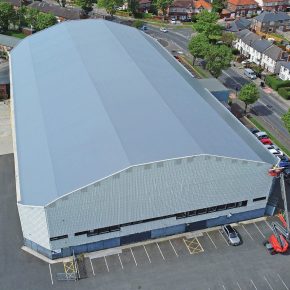
Construction professionals: The 2017 smart home forecast
Emma Bailey explains why virtual assistants with voice-recognition are set to become a new standard in home and building construction in 2017.
Virtual assistants, armed with cutting-edge voice-recognition capabilities, are beginning to fundamentally alter the way we build and interact with our electronic devices. As more of our formerly-analog appliances and tools come online – smoke alarms, door locks, window shades – we need a way to communicate with them that doesn’t require screens or manual button-pressing.
Enter voice recognition technology: after the demonstrations presented at 2017’s global Consumer Electronics Show, held earlier this month in Las Vegas, it’s evident that increasingly “smart” virtual personal assistants are poised to become a new standard in home and building construction.
Virtual assistants and voice command
Virtual assistant software accepts voice input, and then sophisticated speech processing engines analyse this data and decipher what it is the user is trying to do. This is more than just generating a one-to-one representation of the words uttered – although fidelity in capturing speech is important.
Deep learning algorithms combine its understanding of the spoken phrases with the users’ established preferences and previous actions to effectively determine his or her goals. It then acts to carry out the necessary actions to fulfil any requests given.
Smarter phones, smarter homes
Voice recognition applications had been expensive impracticalities for several decades after they were first conceived, but they got a major boost when smartphones became common.
The ubiquity of the cellphone in modern life meant that developers could devote significant resources to the field and make continuous improvements. Apple’s Siri interface for the iPhone was perhaps the first mainstream application of speech recognition and natural language processing.
The next set of opportunities for voice interfaces came from the smart home industry, where most new innovations are being introduced at present.
Home and building control
Using the data processing and automated reasoning power of Amazon’s Alexa software, for instance, users can control automated home devices and make Internet search inquiries simply by speaking into the attached microphone.
They can dim or brighten their lights, adjust the settings on their programmable thermostats and manage other smart appliances simply by verbalising their wishes. Hands-free access to the World Wide Web brings opportunities for online shopping, music playback, scheduling functions and more.
A growing segment of the smart home trade lies in home security: systems can integrate with security solutions to lock and unlock doors, access surveillance cameras and arm alarms.
While most home automation equipment is added on by property owners themselves, smart technology is now starting to gain a foothold in the building sector. According to estimates from MarketsandMarkets, The global smart building market is forecast to grow from $5.73 billion this year to $24.73 billion by 2021.
The ground-up construction of personal-assistant powered smart home involves the installation of a flexible home hub, sufficient electrical wiring to allow for multiple gadgets in every room and the provision of wireless internet connectivity throughout the building.
A more secure future
Everyone who intends to make the installation of smart systems and voice assistants a major part of their business model needs to stay up to date on the latest firmware, security patches and other mechanisms for data protection. This can be tricky because of the myriad of devices manufactured by multiple vendors that employ several distinct communications protocols.
Because waves of data fly through the air to power these robust systems, keeping personal information safe is a top priority. Any data breaches encountered won’t just reflect poorly on the manufacturers of the products in question, but they will also mar the reputation of whoever set them up at the home.
As we head into 2017, future construction professionals would do well to learn as much as possible about the technology that sits at the heart of today’s smart home systems.
By supplying the necessary equipment themselves, construction firms can capture the profits associated with this trend rather than letting them go to retailers or other third parties. Demand for this technology is projected to soar as virtual voice assistants continue to work their way into our daily lives.
Latest news

22nd April 2024
New EJOT role will develop strategic support for UK flat roofing sector
EJOT UK has taken a major step in the expansion of its support for the flat roofing market by appointing one of its most experienced building envelope fastening specialists as its first sector-dedicated business development manager.
Posted in Articles, Building Industry News, Building Products & Structures, Building Systems, Innovations & New Products, Posts, Recruitment, Restoration & Refurbishment, Retrofit & Renovation, Roofs
22nd April 2024
Access2 Wins ADSA-Sponsored Award at AI Specification Awards
Access2 clinched the ADSA-sponsored Product Design and Innovation Award (Electronic) at the AI Specification Awards 2024 on Thursday.
Posted in Access Control & Door Entry Systems, Architectural Ironmongery, Articles, Awards, Building Associations & Institutes, Building Industry Events, Building Industry News, Building Products & Structures, Building Services, Doors, Facility Management & Building Services, Information Technology, Innovations & New Products, Retrofit & Renovation, Security and Fire Protection, Video of the Week
19th April 2024
ASSA ABLOY: Access solutions can impact sustainability performance across the full life-cycle of a building
Embedding sustainability within any organisation requires a broad, strategic perspective. Scrutiny should include the physical infrastructure itself: According to the IEA, buildings consume around 30% of global energy*. ASSA ABLOY has more…
Posted in Access Control & Door Entry Systems, Architectural Ironmongery, Articles, Building Industry News, Building Products & Structures, Building Regulations & Accreditations, Building Services, Case Studies, Doors, Facility Management & Building Services, Information Technology, Research & Materials Testing, Retrofit & Renovation, Security and Fire Protection, Sustainability & Energy Efficiency, Video of the Week
19th April 2024
British weather doesn't dampen spirit for new HMG Garden Paint
Despite one of the wettest starts to the year on record, customers are starting to plan for brighter days with HydroPro Garden Paint from HMG Paints.
Posted in Articles, Building Industry News, Building Products & Structures, Garden, Innovations & New Products, Paints, Paints, Coatings & Finishes, Restoration & Refurbishment, Retrofit & Renovation, Site Preparation, Sustainability & Energy Efficiency, Waste Management & Recycling
 Sign up:
Sign up: